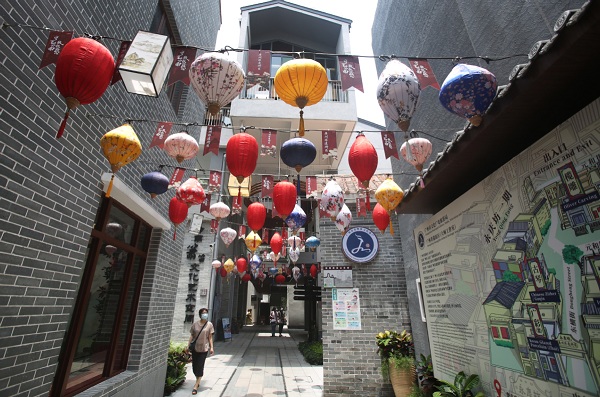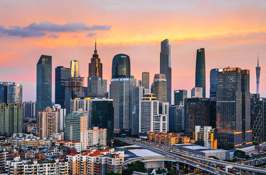Renovation projects protect urban heritage in parts of Guangzhou

Residents view an array of lanterns at Yongqingfang in Guangzhou this month. The neighborhood has been restored and renovated and has now become a hot spot for tourists. ZHENG ERQI/CHINA DAILY
Xu Chaojiang, 72, says he's glad the traditional houses in Guangzhou's Yongqingfang community, where he lives, have been given a face-lift in recent years.
The area, in Guangdong's provincial capital, has become a popular tourist spot dotted with intangible cultural heritage shops, museums and leisure spaces since the first phase of the renovation was completed in 2016.
"It's a day and night difference," Xu said. "The houses were shabby and walls were leaning. My house was fortified (in the renovation).The area looks much more beautiful now and is more comfortable to live in.
"The original building styles remain. The new shops increase the income of local people."
There was a plan to demolish the qilou-traditional arcade-houses-along Enning Street in the area many years ago, but many people opposed it, Xu said. That led to the plan being changed.
"You don't find qilou in many other cities," Xu said. "Like President Xi says, local traditional cultural characteristics should be protected-both tangible and intangible."
When President Xi Jinping visited the Yongqingfang area on Oct 24, 2018, he said historical and cultural protection should be emphasized in city planning.
Local characteristics should be highlighted, the living environment improved and a micro-scale renovation approach employed more widely to pass on the memories of a city and the hometown nostalgia of its people, Xi said.
Covering an area of 113,700 square meters, the Yongqingfang area, located in Liwan district, had 1,352 buildings and 2,760 households before the renovation. It has the largest number of qilou in Guangzhou, with those in Enning Street dating back to 1931.
A former residence of kung fu movie legend Bruce Lee, a museum devoted to Zhan Tianyou, who is known as the "father of China's railways", and Cantonese-style porcelain, embroidery and copper ware shops, among other cultural venues, are located in the area.
In the first-stage renovation, a Cantonese opera museum was built, with Cantonese opera performances staged twice a week on a platform beside a pond. Intangible cultural heritage shops were also opened.
A committee made up of city, district and community representatives participated in the planning, building and management of the area, said Jiang Weihui, an official with the district's housing and development bureau, adding that the second phase of the renovation is expected to be completed this year.
Elsewhere in Guangzhou, the former Nanhai county community in Yuexiu district has also taken on a new look following micro-scale renovation.
With an area of 136,000 sq m, the community housed county government offices during the Ming and Qing dynasties (1368-1911), as well as ancient Taoist and Buddhist temples.
Apart from the renovation of the buildings, overhead cables and the drainage system were also overhauled, with public lighting increased, dangerous trees removed and elderly friendly facilities installed, said Zhang Huimin, Party secretary of Liurong subdistrict.
The community is now more livable and people spend more time sitting and walking in its public spaces. Activities such as glutinous rice dumpling making and outdoor movie sessions are also organized, reminiscent of some people's childhood experiences, said resident Li Zhimin.
To help ensure that elderly residents in need get healthy lunches, more than 300 subsidized lunchboxes costing just 10 yuan ($1.56) each are distributed to seniors every day. There are also 1,036 canteens for elderly people in Guangzhou.
A key economic hub with a population of more than 18 million, Guangzhou was listed in 2017 as one of 15 cities in a trial residential community renovation project organized by the Ministry of Housing and Urban-Rural Development. Such renovation in Guangzhou has taken various forms, including micro-scale renovation projects.
The city government has said it planned to renovate 484 old communities between July last year and the end of this year.
In the next phase, ending in 2025, all the old communities built before 2000 will be reviewed and more renovation will be planned and implemented step by step.



 Print
Print Mail
Mail

